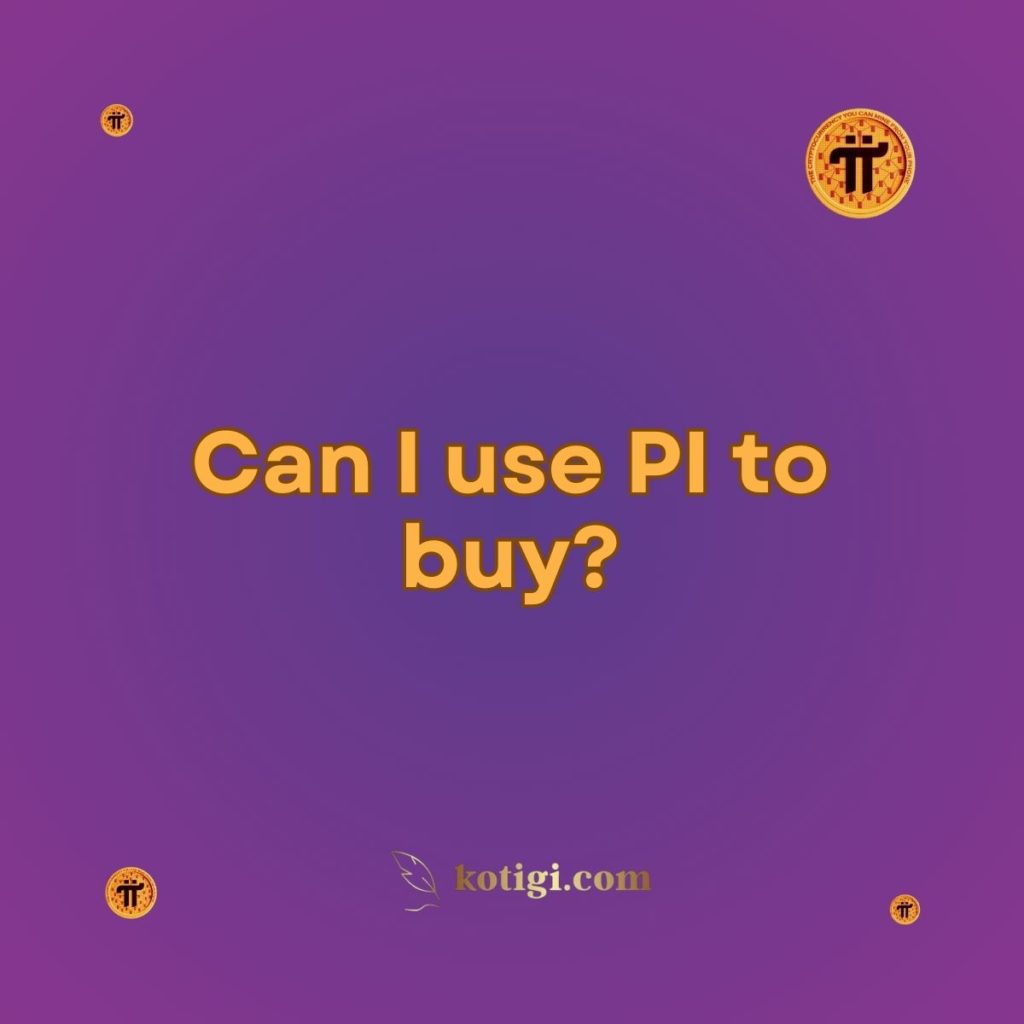
Can I use PI to buy?
Yes, you can use Pi to buy certain goods and services within the Pi Network ecosystem. Although Pi Network is still in its enclosed mainnet phase, users can exchange Pi for products and services from businesses that accept it as payment. However, the full potential for Pi as a purchasing medium will only be realized after the network transitions to open mainnet and Pi becomes tradable on external platforms.
Introduction
As Pi Network gains traction, many users wonder whether Pi can be used to buy goods and services. While Pi coins cannot be traded on external cryptocurrency exchanges yet, they do have value within the Pi Network’s growing internal economy. This post explores how you can currently use Pi coins for purchases and the future potential of Pi as a medium for buying and selling goods.
Understanding Pi Network’s Current State
The Enclosed Mainnet Phase
Pi Network is still in its enclosed mainnet phase, meaning that Pi coins are not yet tradable on public cryptocurrency exchanges. This phase was launched to allow the core team to finalize key technical aspects of the project, including KYC (Know Your Customer) verification and ensuring the network’s security and decentralization.
Despite being in this enclosed phase, Pi coins are already being used in a limited way within the Pi ecosystem. Pi holders can buy goods and services from businesses or individuals who accept Pi, but these transactions are restricted to the Pi Network’s community.
What Can You Buy with Pi?
While Pi cannot be exchanged for fiat currency (like USD or EUR) at this stage, it can be used to purchase a range of goods and services. Pi Network is developing its internal marketplace, where users can trade Pi for real-world items.
Some examples of items available for purchase within the Pi Network ecosystem include:
- Digital goods: E-books, software, and digital art.
- Physical products: Clothing, gadgets, and accessories.
- Services: Freelance work, consultations, and tutoring.
However, it is important to note that the variety of goods and services available for purchase with Pi is still somewhat limited, and the Pi economy is in its early stages.
Using Pi for Transactions
Pi Network Marketplace
The Pi Network marketplace is a decentralized platform where users can buy and sell items using Pi coins. While this marketplace is still in development, it serves as an essential proof-of-concept for the future potential of Pi as a medium of exchange.
To make purchases within the Pi Network marketplace, users must have mined Pi coins and completed the KYC verification process. After completing KYC, they can use their Pi coins to buy products from sellers within the network.
Example Transactions with Pi
Here are some examples of transactions you can currently make within the Pi ecosystem:
- Digital Content: Pi miners who produce digital art or content can sell their work in exchange for Pi. For example, users can purchase unique pieces of digital artwork, access e-books, or subscribe to digital services using Pi.
- Services: Pi miners offering freelance services, such as graphic design, web development, or consulting, can accept Pi as payment from other users. These services create a functional economy within the network, even before the open mainnet is launched.
- Physical Goods: Some users and businesses within the Pi Network have begun offering tangible products such as clothing, electronics, and accessories in exchange for Pi. Although the range of physical goods is still small, it demonstrates the potential of Pi as a payment method for real-world items.
How Will Pi Become More Widely Usable?
Transition to Open Mainnet
The enclosed mainnet phase is expected to transition to the open mainnet, at which point Pi will become tradable on public cryptocurrency exchanges. When this happens, Pi will likely become more widely accepted as a form of payment both within and outside of the Pi Network.
In the open mainnet phase, businesses will be able to integrate Pi as a payment option, much like how Bitcoin and Ethereum are used today. Additionally, users will have the ability to exchange Pi for fiat currencies, making it more convenient to convert Pi into tangible purchasing power.
Growing the Pi Ecosystem
As Pi Network expands, the number of businesses and individuals accepting Pi as payment is expected to grow. Currently, a significant portion of the Pi economy relies on trust between users within the network. Once Pi is fully launched and recognized on exchanges, it will likely attract more merchants and service providers.
In particular, the introduction of decentralized applications (DApps) on Pi’s blockchain could drive adoption of Pi as a currency. DApps built on the Pi Network may offer various use cases where users can spend their Pi coins, increasing the demand for Pi as a medium of exchange.
How to Use Pi to Buy Goods and Services
Step-by-Step Guide to Buying with Pi
If you’re ready to use your Pi coins to make a purchase, here’s a step-by-step guide on how to do so within the Pi Network:
- Complete KYC Verification: Before using Pi for transactions, you must complete the KYC process. This ensures that all users are legitimate and helps prevent fraudulent transactions within the network.
- Access the Pi Marketplace: Once KYC is completed, access the Pi marketplace through the Pi app or via community-run Pi Network groups where goods and services are traded for Pi.
- Select a Seller or Service Provider: Browse the available goods and services offered by other Pi users. Look for reputable sellers with positive feedback to ensure a smooth transaction.
- Negotiate Terms: When buying from another user, you can negotiate the price and terms of the transaction. This can be done through direct messaging within the Pi app or other communication channels.
- Complete the Transaction: After agreeing on the terms, you can transfer the agreed amount of Pi coins to the seller’s wallet. Make sure to confirm the transaction before releasing the Pi coins to avoid any misunderstandings.
- Receive Your Item or Service: Once the seller confirms receipt of payment, they will provide the agreed-upon product or service.
Is It Safe to Use Pi for Purchases?
Transactions within the Pi Network are relatively secure, thanks to the built-in blockchain technology that powers Pi. However, as with any online marketplace, there is always a risk of fraud or disputes. It’s important to use caution when making purchases and to trade with trusted users or verified sellers.
Benefits of Using Pi for Purchases
Low Transaction Fees
One of the key benefits of using Pi for transactions is the low or even nonexistent transaction fees. Since Pi does not rely on energy-intensive proof-of-work mining like Bitcoin, it can process transactions more efficiently and with fewer fees. This makes it an appealing option for both buyers and sellers, particularly in cases where traditional payment methods incur high fees.
Decentralization and Accessibility
Pi’s decentralized nature makes it accessible to users worldwide, even those without access to traditional banking services. By allowing users to mine Pi on their smartphones and use it for transactions, Pi Network empowers individuals who may be excluded from the global financial system. This accessibility contributes to Pi’s potential as a widely accepted medium of exchange.
Early Adoption Opportunities
As an early participant in the Pi Network, you have the opportunity to take advantage of Pi’s growing economy before it becomes fully mainstream. By using Pi to buy goods and services now, you can participate in the development of this unique cryptocurrency ecosystem and contribute to its growth.
Challenges and Limitations
Limited Usability Outside Pi Network
Currently, Pi’s use as a currency is limited to transactions within the Pi Network ecosystem. Until Pi becomes tradable on cryptocurrency exchanges and more widely accepted by external merchants, its usability will remain restricted. This makes it difficult to convert Pi directly into cash or use it to make purchases from major retailers.
Value Uncertainty
Another challenge is the uncertainty surrounding Pi’s future value. Since Pi has not yet been listed on public exchanges, its value remains speculative. While many believe that Pi will gain value once the open mainnet launches, there is no guarantee that it will achieve significant market value. As a result, using Pi for purchases comes with the risk of spending an asset that could potentially increase in value.
Future Potential of Pi as a Payment Method
Adoption by Businesses
As Pi Network grows and gains more visibility, it’s possible that businesses outside the Pi ecosystem will begin accepting Pi as a payment method. Major companies like Tesla and PayPal have already started accepting Bitcoin, and Pi could follow a similar trajectory once it is listed on exchanges and recognized as a legitimate cryptocurrency.
In the future, users may be able to use Pi to pay for a variety of goods and services, including online shopping, travel, and digital content. The success of Pi as a payment method will depend on its market adoption and how well it can integrate into existing payment infrastructures.
Integration with Cryptocurrency Wallets
Another potential development for Pi is its integration with popular cryptocurrency wallets. Once Pi is tradable, it could be stored in digital wallets like MetaMask or Trust Wallet, allowing users to make seamless transactions across different platforms. This would greatly expand Pi’s usability and make it easier for users to spend Pi on a wide range of products and services.
Conclusion
While Pi is not yet widely accepted as a currency, it can already be used to buy goods and services within the Pi Network ecosystem. As Pi Network continues to develop and eventually transitions to the open mainnet, the potential for Pi to be used as a medium of exchange will grow. Early adopters who participate in the Pi economy now may find themselves well-positioned to benefit from Pi’s future growth and wider acceptance.
For now, Pi users can explore the internal marketplace and begin using their Pi coins for transactions within the community. As the network expands and gains recognition, Pi’s value as a currency will become clearer.
Key Takeaways:
- Pi can be used to buy goods and services within the Pi Network’s internal marketplace.
- The enclosed mainnet phase limits Pi’s usability outside the network.
- The open mainnet phase will likely increase Pi’s acceptance as a form of payment.
- Users must complete KYC verification to engage in transactions within the Pi ecosystem.
- The future potential of Pi as a payment method depends on its market adoption and integration with external platforms.





